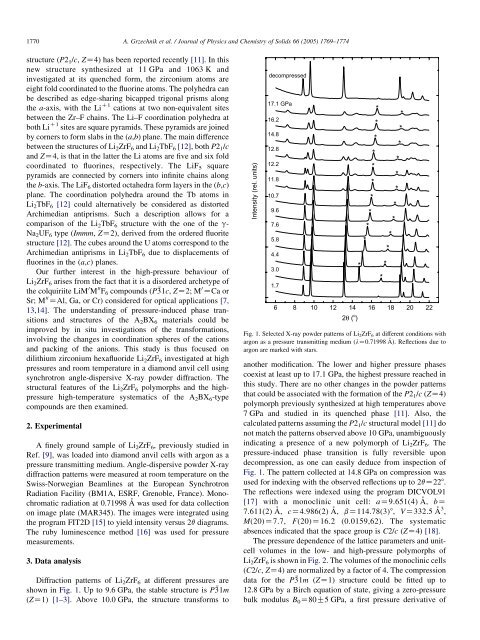Dilithium zirconium hexafluoride Li2ZrF6 at high ... - ResearchGate
Dilithium zirconium hexafluoride Li2ZrF6 at high ... - ResearchGate
Dilithium zirconium hexafluoride Li2ZrF6 at high ... - ResearchGate
You also want an ePaper? Increase the reach of your titles
YUMPU automatically turns print PDFs into web optimized ePapers that Google loves.
1770<br />
structure (P21/c, ZZ4) has been reported recently [11]. In this<br />
new structure synthesized <strong>at</strong> 11 GPa and 1063 K and<br />
investig<strong>at</strong>ed <strong>at</strong> its quenched form, the <strong>zirconium</strong> <strong>at</strong>oms are<br />
eight fold coordin<strong>at</strong>ed to the fluorine <strong>at</strong>oms. The polyhedra can<br />
be described as edge-sharing bicapped trigonal prisms along<br />
the a-axis, with the Li C1 c<strong>at</strong>ions <strong>at</strong> two non-equivalent sites<br />
between the Zr–F chains. The Li–F coordin<strong>at</strong>ion polyhedra <strong>at</strong><br />
both Li C1 sites are square pyramids. These pyramids are joined<br />
by corners to form slabs in the (a,b) plane. The main difference<br />
between the structures of <strong>Li2ZrF6</strong> and Li2TbF6 [12], both P21/c<br />
and ZZ4, is th<strong>at</strong> in the l<strong>at</strong>ter the Li <strong>at</strong>oms are five and six fold<br />
coordin<strong>at</strong>ed to fluorines, respectively. The LiF5 square<br />
pyramids are connected by corners into infinite chains along<br />
the b-axis. The LiF 6 distorted octahedra form layers in the (b,c)<br />
plane. The coordin<strong>at</strong>ion polyhedra around the Tb <strong>at</strong>oms in<br />
Li2TbF6 [12] could altern<strong>at</strong>ively be considered as distorted<br />
Archimedian antiprisms. Such a description allows for a<br />
comparison of the Li2TbF6 structure with the one of the g-<br />
Na2UF6 type (Immm, ZZ2), derived from the ordered fluorite<br />
structure [12]. The cubes around the U <strong>at</strong>oms correspond to the<br />
Archimedian antiprisms in Li2TbF6 due to displacements of<br />
fluorines in the (a,c) planes.<br />
Our further interest in the <strong>high</strong>-pressure behaviour of<br />
<strong>Li2ZrF6</strong> arises from the fact th<strong>at</strong> it is a disordered archetype of<br />
the colquiriite LiM 0 M 00 F6 compounds (P31c, ZZ2; M 0 ZCa or<br />
Sr; M 00 ZAl, Ga, or Cr) considered for optical applic<strong>at</strong>ions [7,<br />
13,14]. The understanding of pressure-induced phase transitions<br />
and structures of the A2BX6 m<strong>at</strong>erials could be<br />
improved by in situ investig<strong>at</strong>ions of the transform<strong>at</strong>ions,<br />
involving the changes in coordin<strong>at</strong>ion spheres of the c<strong>at</strong>ions<br />
and packing of the anions. This study is thus focused on<br />
dilithium <strong>zirconium</strong> <strong>hexafluoride</strong> <strong>Li2ZrF6</strong> investig<strong>at</strong>ed <strong>at</strong> <strong>high</strong><br />
pressures and room temper<strong>at</strong>ure in a diamond anvil cell using<br />
synchrotron angle-dispersive X-ray powder diffraction. The<br />
structural fe<strong>at</strong>ures of the <strong>Li2ZrF6</strong> polymorphs and the <strong>high</strong>pressure<br />
<strong>high</strong>-temper<strong>at</strong>ure system<strong>at</strong>ics of the A2BX6-type<br />
compounds are then examined.<br />
2. Experimental<br />
A finely ground sample of <strong>Li2ZrF6</strong>, previously studied in<br />
Ref. [9], was loaded into diamond anvil cells with argon as a<br />
pressure transmitting medium. Angle-dispersive powder X-ray<br />
diffraction p<strong>at</strong>terns were measured <strong>at</strong> room temper<strong>at</strong>ure on the<br />
Swiss-Norwegian Beamlines <strong>at</strong> the European Synchrotron<br />
Radi<strong>at</strong>ion Facility (BM1A, ESRF, Grenoble, France). Monochrom<strong>at</strong>ic<br />
radi<strong>at</strong>ion <strong>at</strong> 0.71998 A˚ was used for d<strong>at</strong>a collection<br />
on image pl<strong>at</strong>e (MAR345). The images were integr<strong>at</strong>ed using<br />
the program FIT2D [15] to yield intensity versus 2q diagrams.<br />
The ruby luminescence method [16] was used for pressure<br />
measurements.<br />
3. D<strong>at</strong>a analysis<br />
A. Grzechnik et al. / Journal of Physics and Chemistry of Solids 66 (2005) 1769–1774<br />
Diffraction p<strong>at</strong>terns of <strong>Li2ZrF6</strong> <strong>at</strong> different pressures are<br />
shown in Fig. 1. Up to 9.6 GPa, the stable structure is P31m<br />
(ZZ1) [1–3]. Above 10.0 GPa, the structure transforms to<br />
Intensity (rel. units)<br />
decompressed<br />
17.1 GPa<br />
16.2<br />
14.8<br />
12.8<br />
12.2<br />
11.8<br />
10.7<br />
9.6<br />
7.6<br />
5.8<br />
4.4<br />
3.0<br />
1.7<br />
6 8 10 12 14<br />
2θ (<br />
16 18 20 22<br />
o )<br />
another modific<strong>at</strong>ion. The lower and <strong>high</strong>er pressure phases<br />
coexist <strong>at</strong> least up to 17.1 GPa, the <strong>high</strong>est pressure reached in<br />
this study. There are no other changes in the powder p<strong>at</strong>terns<br />
th<strong>at</strong> could be associ<strong>at</strong>ed with the form<strong>at</strong>ion of the P21/c (ZZ4)<br />
polymorph previously synthesized <strong>at</strong> <strong>high</strong> temper<strong>at</strong>ures above<br />
7 GPa and studied in its quenched phase [11]. Also, the<br />
calcul<strong>at</strong>ed p<strong>at</strong>terns assuming the P2 1/c structural model [11] do<br />
not m<strong>at</strong>ch the p<strong>at</strong>terns observed above 10 GPa, unambiguously<br />
indic<strong>at</strong>ing a presence of a new polymorph of <strong>Li2ZrF6</strong>. The<br />
pressure-induced phase transition is fully reversible upon<br />
decompression, as one can easily deduce from inspection of<br />
Fig. 1. The p<strong>at</strong>tern collected <strong>at</strong> 14.8 GPa on compression was<br />
used for indexing with the observed reflections up to 2qZ228.<br />
The reflections were indexed using the program DICVOL91<br />
[17] with a monoclinic unit cell: aZ9.651(4) A˚ , bZ<br />
7.611(2) A˚ , cZ4.986(2) A˚ , bZ114.78(3)8, VZ332.5 A˚ 3 ,<br />
M(20)Z7.7, F(20)Z16.2 (0.0159,62). The system<strong>at</strong>ic<br />
absences indic<strong>at</strong>ed th<strong>at</strong> the space group is C2/c (ZZ4) [18].<br />
The pressure dependence of the l<strong>at</strong>tice parameters and unitcell<br />
volumes in the low- and <strong>high</strong>-pressure polymorphs of<br />
<strong>Li2ZrF6</strong> is shown in Fig. 2. The volumes of the monoclinic cells<br />
(C2/c, ZZ4) are normalized by a factor of 4. The compression<br />
d<strong>at</strong>a for the P31m (ZZ1) structure could be fitted up to<br />
12.8 GPa by a Birch equ<strong>at</strong>ion of st<strong>at</strong>e, giving a zero-pressure<br />
bulk modulus B0Z80G5 GPa, a first pressure deriv<strong>at</strong>ive of<br />
*<br />
*<br />
*<br />
*<br />
*<br />
*<br />
*<br />
*<br />
*<br />
*<br />
*<br />
*<br />
Fig. 1. Selected X-ray powder p<strong>at</strong>terns of <strong>Li2ZrF6</strong> <strong>at</strong> different conditions with<br />
argon as a pressure transmitting medium (lZ0.71998 A˚ ). Reflections due to<br />
argon are marked with stars.<br />
*<br />
*<br />
*<br />
*<br />
*<br />
*<br />
*<br />
*<br />
*<br />
*<br />
*<br />
*




